Cave diving in the Ottawa River, Canada
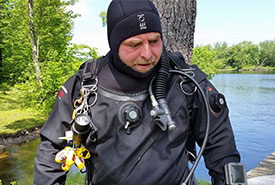
Dressed and ready to enter the water - note the yellow loggers on my right. (Photo by Cheryl Buzzacott)
Before coming to Canada I contacted renowned Canadian cave diver David Sawatzky, whom I knew had mapped these caves in the 1990s before moving to Nova Scotia. David kindly sent me his detailed map and some background information, including that the area in which the caves are located was recently purchased by the Nature Conservancy of Canada (NCC). Two weeks before flying out I received word that NCC had approved my application for a research permit to dive their caves.
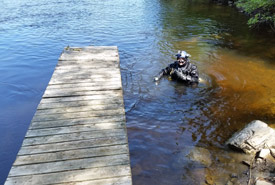
Leaving the shore (Photo by Cheryl Buzzacott)
The area in which the caves are located predominantly rests upon granite, but large pockets of Ordovician limestone karst exist and in these pockets we find Canada’s most extensive cave systems. The Westmeath freshwater caves were carved out by water shortcutting through fractures rather than flowing around bends in the river. Depths are shallow, usually 10–30 feet (three to nine metres), and the passages cut through or under islands, traverse multiple entry ponds and many even end in mid-river resurgences.
I visited the caves during a weekend biodiversity blitz organized by NCC, which started with a welcome brief and introductions by NCC staff and participants. With so many scientists in the group, conservation conversation was animated. Among the participants who carried out the blitz on land, I was the only diver in the group.
I geared-up in chest-deep water near a convenient dock, then entered the cave, leaving a water temperature logger near the entry. The area had had substantial rain in recent weeks and the river was three feet higher than normal, so the flow through the cave was really pumping. The water was the colour of strong tea and visibility no more than three feet.
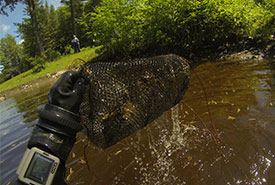
Holding up the home-made fish trap.(Photo by Peter Buzzacott)
Soon I reached a nearby pool and surfaced to look around. Just before the ascent I spotted a homemade fish trap, probably left by some holidaying children, so I recovered that to prevent unnecessary loss of aquatic life. Then, when I lifted it out of the water I realized there was a 10-inch-long (25-centimetres) salamander in it.
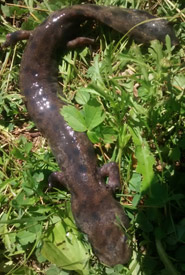
Mud puppy (Photo by Ben Teskey)
I handed the salamander over to Ben, an NCC summer technician who set the poor thing free after I’d re-entered the cave. I then headed further upstream, passing organic forms growing on sticks and rubble. Turning over a small rock, I found a white crustacean a few millimetres long with antennae. It didn’t react to my light but these caves are so long and yet rich in nutrient throughput that I wondered how likely it is that cave-adapted species might live in here, awaiting discovery.
We’d been asked to collect a few shells for a mussel expert at the Canadian Museum of Nature to identify resident molluscs. Inside the cave I found large concentrations of big mussels, many open and feeding. I collected a few empty mussel shells and also a gastropod, a cephalopod and a brachiopod. Maybe these ancient shells were cut free from the limestone. I picked up a tabulate coral, blackened on one side (so recently released from the limestone I’m guessing).
Turning my dive, I swam out passed a walleye fish, then at the exit I collected my temperature logger and came across a snapping turtle. My first day had been a great success.
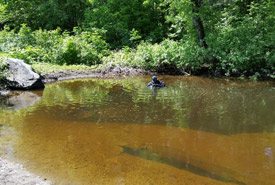
Surfacing in a pond after a traverse (Photo by Cheryl Buzzacott)
The next day the local neighbour Jim collected me at the dock and took me up river to the west side of the peninsula, where a couple of passages on the map intrigued me. Entry to the small bay was made easier due to the higher-than-normal water but boils on the surface suggested a substantial flow.
I geared up on the shore after Jim left to collect the rest of the NCC team. Silently I slipped below the surface. Within three feet it was pitch-black so I tied off a reel and searched about for the main line.
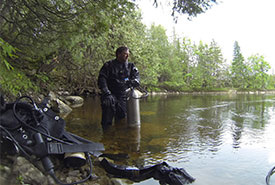
A moment of reflection after the dive. (Photo by Peter Buzzacott)
Soon I found it and headed in, my hands outstretched ahead of me in the dark. Below me I found big river mussels and above the cave entrance I’d spotted piles of mussel shells on the river bank, so otters must live here, eating mussels that are fed by nutrient flow concentrated by the cave.
Acknowledgements: My sincere thanks to the Nature Conservancy of Canada for permission to visit these dynamic and precious ecosystems, thanks to David Sawatsky and Paul Heinerth for their assistance in making this happen and a special mention to Jim who made this cave diver welcome.
PostScript: When the temperature loggers were downloaded the water temperature on the first day was 14.4 degrees Celsius and on the second day in the western cave it was 15.4 degrees Celsius, indicating that the water flowing through each cave may be sourced from different depths in the river. The scientists that weekend identified 198 species, being 105 fauna, 92 flora and one mushroom.* None of the identified animals were fish or crustacean, and yet the caves are home to many species of these.
This article originally appeared in the June 2015 edition of Guidelines, a publication by Cave Divers Association of Australia, and is reposted with permission on Land Lines.
*Updated number of species recorded as of Sept. 17, 2015:
- Animals: 207
- Mammals: 5
- Reptiles: 2
- Birds: 43
- Insects: 142
- Other invertebrates: 6
- Plants: 92
- Mushroom: 1
A total of 300 species identified.


